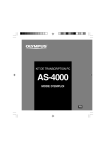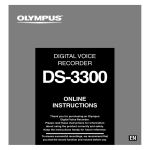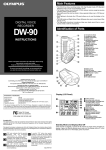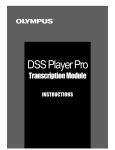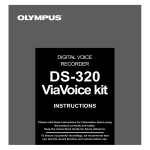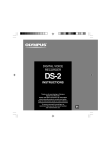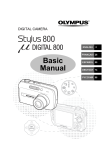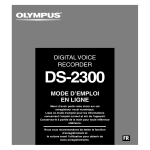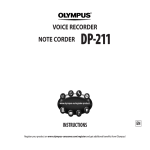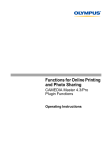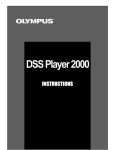Download AS-4000 user manual
Transcript
PC TRANSCRIPTION KIT AS-4000 ONLINE INSTRUCTIONS EN DSS Player Pro Transcription Module Features - Plays files in the background when another application is running, such as a word processor. - Automatically runs a word processor when replaying a dictation file starts, so that transcription can be started immediately.* - Receives dictation files and sends created document files by e-mail or FTP.* - Sorts received dictation files by sender, and automatically sends created document files.* - Manages created document files in association with dictation files.* - Enables foot switch control of the playback process. * Windows only ● OLYMPUS IMAGING CORPORATION holds the copyrights for DSS Player Pro Transcription Module software and the instructions (this manual). ● Microsoft and Windows are registered trademarks of Microsoft Corporation. ● Apple, Macintosh, iMac, eMac, Mac, and PowerMac are trademarks or registered trademarks of Apple Computer, Inc. ● Intel and Pentium are registered trademarks of Intel Corporation. ● Other product and brand names mentioned herein may be the trademarks or registered trademarks of their respective owners. 2 Table of Contents Introduction Minimum Requirement ......................... 4 Getting Ready Installing DSS Player Software ............ 6 Using Online Help ................................. 8 Uninstalling DSS Player Software ........ 7 Let’s Get Started Running DSS Player ............................. 9 Connecting the RS25/RS26 Foot Switch... 11 Connecting the E61 Headset ............. 12 Setting a Word Processor or Document Management ............. 17 Receiving Dictation Files/Sending Window Names ................................... 13 Document Files ............................... 18 Downloading Dictation Files ............... 14 Setting the E-mail/FTP Service .......... 21 Starting Transcription ......................... 16 User Support Technical Assistance and Support ..... 28 3 Minimum Requirement Windows PC: IBM PC/AT compatible PC Minimum Requirement Operating System: Microsoft Windows 98/ 98SE/ Me/ 2000 Professional/ XP Professional,Home Edition CPU: Intel Pentium II class 333 MHz processor or faster (Processor 500MHz or faster is recommended) RAM: 128 MB or more (256 MB or more is recommended) Hard drive space: 50 MB or more Drive: 2x or faster CD-ROM, CD-R, CD-RW, DVD-ROM drive Sound card: Creative Labs Sound Blaster 16 or 100% compatible sound card Browser: Microsoft Internet Explorer 4.01 SP2 or later Display: 800 x 600 pixels or more, 256 colors or more USB port: One or more free ports Audio I/O terminals: Microphone input and earphone output or speaker 4 Macintosh Power Mac G3 233 MHz class processor or faster iMac/ iBook/ eMac/ Power Mac/ PowerBook (The computer must support a standard USB port.) Operating System: Mac OS 9.0-9.2.2/10.1-10.3 RAM: OS 9.x 64 MB or more (128 MB or more is recommended) OS X 128 MB or more (256 MB or more is recommended) Hard drive space: 50 MB or more Drive: 2x or faster CD-ROM, CD-R, CD-RW, DVD-ROM drive Display: 800 x 600 pixels or more, 256 colors or more USB port: One or more free ports Minimum Requirement PC: Audio I/O terminals: Earphone output or speakers ................................................................................................................................................................. Notes • To use the voice recognition function with the recorder, use Windows 98SE or later versions of the OS. • Macintosh version does not support voice recognition software. 5 Installing DSS Player Software Be sure to confirm the following before installation: • Exit all running applications. • Eject the floppy disk if you are using one. • If you are running Windows 2000/XP (Professional only) or Mac OS X on the network, you need to log on as an Administrator. * “DSS Player” in this manual refers to the DSS Player Pro Transcription Module. Installing DSS Player Software Windows 1 Insert Olympus DSS Player CD into the CD-ROM drive. The installation program will start automatically. If the installation program does not start automatically, browse your CD-ROM drive and execute “setup.exe”. 2 3 The installation Language Selection dialog box appears. 4 Proceed with the installation according to the instructions on the screen. Select the desired language. Register user information. Enter your name, company name, and license ID number (serial number). The license ID number is printed on the license ID card included inside the recorder package. Click the [Next] button. When confirmation dialog box appears, click the [Yes] button. Macintosh 1 2 3 4 Insert Olympus DSS Player CD into the CD-ROM drive. Double-click the CD icon. Select the folders named “Mac OS 9.x” and “Mac OS X” and start up your OS. Double-click the following icon. Select the folder of which the language is to be installed, and execute the installation program in the folder. Proceed with the installation according to the instructions on the screen. ................................................................................................................................................................. Note 6 Never install DSS Player in Mac OS 9.x system, when using DSS Player with Mac OS X. The device connected when using classic environment may not be recognized. Uninstalling DSS Player Software Windows Exit DSS Player program. Click the [start] button on the taskbar. 1 2 Exit DSS Player. 3 Delete the Executable file. 4 Delete the Driver files. 5 Delete the Help file. Select [Add/Remove programs] from the [Control Panel]. A list of installed applications is displayed. Select [Olympus DSS Player Pro], then click the [Change/Remove] button. Proceed with the installation according to the instructions on the screen. Delete the Preferences file. Delete the [DSS Preference] file in the following location. (OS X) Macintosh HD: User: Library: Preferences (OS 9.x) Macintosh HD: System Folder: Preferences Uninstalling DSS Player Software 1 2 3 4 5 Macintosh Delete the [DSS Player for Mac](OS 9.x) /[DSS Player](OS X) file in the location where you installed the file. For OS X users, uninstalling has been completed. For OS 9.x users, proceed to step 4. Delete the following files in the following location. System Folder: Function Enhancement [DSS 10USB Driver] [DSS 10USB Shim] [DSS 1USB Driver] [DSS 1USB Shim] [DSS FSUSB Driver] [DSS FSUSB Shim] [DSS USB Driver] [DSS USB Shim] Delete the [DSS Player for Mac Help] file in the following location. System Folder: Help ................................................................................................................................................................. Note Uninstallation does not erase the stored dictation files. 7 Using Online Help For information on the DSS Player usage and features, refer to the online Help. To start online Help: Windows Using Online Help • Click the [start] button, then select [All Programs], [Olympus DSS Player Pro], [Transcription Help]. • While DSS Player is running, select the [Help] menu, [Contents] . • While DSS Player is running, press F1 on the keyboard. Macintosh • While DSS Player is running, select [DSS Player for Mac Help] (OS 9.x)/ [DSS Player Help] (OS X) from the [Help] menu. ................................................................................................................................................................. Note Online Help is available after the DSS Player is installed. 8 Running DSS Player To start the Transcription Module, follow these steps: Windows 1 2 3 Start Windows. Click the [start] button, then select [All Programs]. All program menu will be displayed. Select [Olympus DSS Player Pro], then click [Transcription Module]. Running DSS Player 2 3 ................................................................................................................................................................. Notes • If you connect the foot switch via the USB cable before installing DSS Player, the “Add New Hardware Wizard” dialog box will open. If this happens, click [Cancel] to exit the wizard, then install DSS Player software. • If you install DSS Player Pro, Device Detector that makes DSS Player run automatically when connecting Olympus Digital Voice Recorder will be installed.Device Detector will always be displayed as icon in the task tray. 9 Running DSS Player Macintosh 1 2 Start your Macintosh. Double-click the [DSS Player for Mac] (OS 9.x)/[DSS Player] (OS X) folder. The DSS Player (for Mac) folder opens. Running DSS Player 3 Double-click DSS Player. 4 Register user information (OS X). 2 DSS Player for Mac (OS 9.x)/DSS Player Plus (OS X) launches. For the OS X users: “The user ’s registration screen” is displayed when first launched. The users registration screen will be displayed at the time of initial startup. Please input the serial number. Please see the seal attached to the CDROM package included with the DSS Player, for the serial number. After the input has ended, click [OK] to complete the registration. 3 ................................................................................................................................................................ Note The Mac version DSS Player does not have the automatic start function. 10 Connecting the RS25/RS26 Foot Switch Windows Macintosh Connecting to a USB Port 1 2 Connect the foot switch cable to the USB adapter cable. 1 Connect the USB adapter cable to the PC’s USB port. 2 USB adapter Windows Connecting to a Serial Port 1 2 Connect the serial adapter cable to the PC’s serial port. Serial adapter Foot switch setting 3 4 Start the DSS Player and select “Foot Switch Settings” from the “Tools” menu. Select the foot switch connection method and the function for each of the three switches. Connecting the RS25/RS26 Foot Switch 1 2 Connect the foot switch cable to the serial adapter cable. ................................................................................................................................................................ Note The RS25/RS26 foot switch works only with the DSS Player. 11 Connecting the E61 Headset Connecting the E61 Headset ➔ The E61 is a stereo headset. When playing stereo sound, wear the set properly, observing the L and R markings. S T ERE Plug the headset into the PC’s earphone terminal . ............................................................................................. Note If your PC does not have a terminal marked with headset into a terminal marked with or . 12 , plug the O H EA D S E T E 6 1 Window Names * Main screen is displayed when DSS Player is started. 1 5 2 1 2 4 Window Names Windows 3 Macintosh 1 Playback Control Bar Control buttons to play and stop dictation files. 2 Transcriptionist Tree View Displays the directory structure of the folders in which dictation files and document files are stored. 4 Device Tree View Displays the directory structure of the folders in the recorder. 5 Dictation List View Displays the dictation files in the folder selected in 2 and 5. 3 Dictation Tree View Displays the directory structure of the folders in which dictation files are stored. 13 Downloading Dictation Files To save dictation files to DSS Player Pro Transcription Module, follow these steps. Downloading a Dictation from with the Recorder Windows 1 2 Macintosh Connect the recorder. For instruction on how to connect the recorder, check the recorder manual. Click the [Download] icon on the toolbar. The dictation file is downloaded and saved to the corresponding folder in the Download Tray. Downloading Dictation Files Mapping to a Shared Folder on the Network Windows 1 2 3 Right-click a folder in the Download Tray, and select [Properties] from the drop down menu. In the dialog box, click the [Move…] button, and select a folder on the network. Click the [OK] button to finish setting. In the main screen, clicking the folder specified as the shared folder displays the contents in the Dictation List View. Macintosh 1 2 14 From the [Tools] menu, select [Options], and open the [Folder] tab. Set the Message folder as the shared folder on the network. 3 2 Downloading a Dictation File Sent by E-mail or FTP Windows 1 2 Create a Client Profile for E-mail or FTP. For the profile settings, see P.18. For details. Follow the on screen instruction. On the toolbar, click the [Send/Receive files] icon. The transcription module will automatically connect to your E-mail and FTP location specified in the Client Profile. New dictation will be downloaded and saved into the Inbox folder in the Transcriptionist Tree View by default. If a Client Profile is created and an alternate folder is specified, the dictation will be saved to that folder (☞ P.18). ............................................................................................................................................................................. DSS Player for Mac cannot directly receive a file sent by E-mail or FTP. When a dictation file is received with other mail or FTP software, save the file with the software, and then download it to DSS Player for Mac using the [Import File] command from the [File] menu. Downloading Dictation Files Note 15 Starting Transcription Windows Starting Transcription 1 2 3 Select the folder. 4 To end transcription, click the in the Transcribe bar. 5 To complete transcription, select [Finished]. Select the folder where the dictation file resides. Select the dictation file. Select the dictation file to play from the Dictation List View. On the toolbar, click the button. The transcribe bar will appears while the main windows is hidden from view. A word processing application or another program can be set to start automatically. For setting, see P.17. Playback of dictation file can be controlled with the connected foot switch or the buttons on the Transcribe bar. 3 1 2 4 button The dialog box for setting the status of the transcribed file appears. The dictation will be moved to the [Finished] folder in the Transcriptionist Tree View and the transcribed document will be saved to the Documents folder. 5 The created document file is associated with the dictation file. When a folder in the Transcriptionist Tree View is opened and any dictation file in the folder has an associated document file, the document file is listed under the Document column. ............................................................................................................................................................................. Notes • When transcribing a dictation file sent by E-mail or FTP from the DSS Player Pro Dictation Module Release 4 or later is completed, the created document file is automatically returned to the sender of the dictation file. • With DSS Player for Mac, a word processor cannot be set to automatically run when replaying a selected dictation file starts. After selecting a dictation file, control the foot switch to start transcribing. 16 Setting a Word Processor or Document Management You can set a word processor or template file used for transcribing.This will run the set application or file automatically when starting transcribing. Windows Setting a Word Processor To set a word processor for transcription, follow these steps. From the [Tools] menu, select [Options]. Select the [Send] tab, and set the word processor software. Click the [OK] button to save setting. 2 Setting a Document Management The Document Management function allows the association of word processor template with Author ID or Work Type ID. Create and save the templates to be used beforehand. 1 2 Check [Enable Document Management]. Configure the template as required. A template can be set for each Work Type ID or Author ID. Select Work Type ID or Author ID, and click the [Add] button. In the Template Association dialog box, enter the Work Type/ Author ID, and select the desired template file. 1 2 Setting a Word Processor or Document Management 1 2 3 17 Receiving Dictation Files/Sending Document Files Windows The transcription module will automatically send the document to the dictation sender or to a third party as specified in the Client Profile.This process can be automated by configuring the DSS Player with the Client Profile information and the sending method. Setting the E-mail/FTP Service E-mail/FTP service needs to be set to send/receive files. See the E-mail/FTP service setting on P.21-28. Setting the Client Profile Receiving Dictation Files/Sending Document Files If a Client Profile is created, destination folder for the dictation files can be specified. The transcribe documents of the dictation file will be sent back to the sender or to an alternate E-mail address or FTP location specified in the Client Profile. 1 2 From the [Tools] menu, select [Options], then click the [Receive] tab in the Option dialog box. Click the [Create] button, and create a Client Profile for each sender. By creating Client Profile, received dictation files can be sorted by sender, and the designation to send back document files can be also specified. Protocol Select method of sending dictation files from the sender. Dictation Sender 2 Select a sender. To do this, a E-mail or FTP Profiler must be already created for the protocol selected on the [E-mail/FTP] tab (☞ P.21). Clicking the [Address Book] button opens the dialog box to select a dictation sender. 18 Document Receiver Specify the destination to send back document files. This setting item is available when the function to send documents is enabled on the [Send] tab (☞ P.20). Enable Encryption/Decryption Enter the password to decrypt when a received file is encrypted. Destination Folder Select a default folder to save dictation files received from the sender. 1 2 3 4 5 From the Transcriptionist Tree View, select the Documents folder. Right-click the document file, select [Send File], and then select E-mail or FTP for the sending method. The Send dialog box appears. In the dialog box for specifying the destination, enter the destination to send the file. In the Send dialog box, click the [Send] button. The file is saved to the Outbox until the file transmission is actually carried out. On the toolbar, click the [Send/Receive files] button. When the connection to the server is established, the file stored in the Outbox is sent. Receiving Dictation Files/Sending Document Files Manually Sending Document Files ............................................................................................................................................................................. Note When using E-mail and/or FTP for sending/receiving files, see P.18-26 to configure the settings. 19 Receiving Dictation Files/Sending Document Files Automatically Receiving Dictation Files Enabling this function allows the transcription module to automatically check for new dictation files. 1 2 Receiving Dictation Files/Sending Document Files 20 From the [Tools] menu, select [Options], then click the [Receive] tab in the Option dialog box. Check [Auto Receive], and enter the time interval to attempt to receive dictation files. 2 Automatically Sending Document Files 1 2 3 From the [Tools] menu, select [Options], then click the [Send] tab in the Option dialog box. 2 Check [Automatically send documents every], and enter the time interval to attempt to send document files. Check [Enable Document Management], then check [Automatically place outgoing transcribed document in the Outbox folder]. When dictation file transcription is complete, the created document file is saved to the Outbox folder. Files in the Outbox folder are automatically sent at the specified interval. Check “Send the document to the specified address in Client Profile” to send the document to the alternate address specified in the Document Reciever section of the Client Profile instead of the sender address (☞ P.19). 3 Setting the E-mail/FTP Service Windows When using E-mail and/or FTP to retrieve dictation files attachments and/or send typed documents, it is important to configure the E-mail/FTP service in the DSS Player to match that of the E-mail/FTP program you have configured on your PC. Please consult with your system administrator if you need help with setting your E-mail/FTP service. 1 2 From the DSS Player main window, click the [Tools] menu, select [Options], then click the [E-mail/FTP] tab. Create a profile which specifies the destination. When E-mail is used to send and/or receive files, select the type of E-mail service used on your system. Internet E-mail Select when using E-mail, connecting to POP3 or SMTP server via an internet service provider. Corporate or Workgroup Setting the E-mail/FTP Service A profile must be created for each account to be connected. To create a profile, select the sending method, and click the [Setting] button. Select when using MAPI Compliant services such as Microsoft Exchange, Lotus Notes or Group Wise. For details on the setting procedure (☞ P.22). 3 Select a profile. When the setting is complete, click the [OK] button to enable the setting. 21 Setting the E-mail/FTP Service Setting Connection for the MAPI Compliant Service 1 2 Setting the E-mail/FTP Service 22 Click the [start] button of Windows OS, select [Settings], then [Control Panel]. The [Control Panel] appears. Check whether the [Mail] or [Mail and Fax] icon Panel. is present in the Control If the icon exists, the MAPI subsystem has already been installed on your computer. Go to the “Activating Send Mail Function” section in this manual (☞ P.26). If the icon does not exist, install the MAPI subsystem. The MAPI subsystem will be installed when Microsoft Exchange Client, or Microsoft Outlook is installed. Microsoft Outlook is included in the Microsoft Office. Installing the MAPI Subsystem Installing Microsoft Outlook 98 1 Start the Setup program for Outlook 98. 2 When the following window appears, select [Corporate or Workgroup] and click the [Next] button. 3 Follow the instructions on screen. When the following window appears, select [Other Mail Applications] and click the [Next] button. Installing Microsoft Outlook 2000 2 Select [Corporate or Workgroup] and click the [Next] button. When the following window appears, click the [Next] button. A dialog box for setting up Microsoft Outlook appears. This is the wizard for creating a profile. For information on creating a profile, check Step 3 in the “Activating Send Mail Function” (☞ P.26). Setting the E-mail/FTP Service 1 After installing Outlook 2000, start the program. 3 23 Setting the E-mail/FTP Service Installing Microsoft Outlook XP/2003 1 Setting the E-mail/FTP Service 24 After installing Outlook XP, doubleclick the [Mail] icon in the [Control Panel], and then click the [Show Profiles…] button. 2 Click the [Add…] button. 3 Type the profile name and click the [OK] button. 4 Select “Add a new e-mail account” and click the [Next] button. 5 Select your e-mail server type. If you are going to use an MAPI compliant Workgroup system such as Lotus Notes or Novell GroupWise, select “Additional Server Types”, click the [Next] button to continue. If you are going to use an internet standard E-mail account, select “POP3” server, click the [Next] button, and skip to Step 7. 6 Click the [Connection] tab in the following dialog box and make sure the appropriate connection method is selected. If you select “Additional Server Types”, you will see the following dialog box. Click the [Next] button and follow the instructions on the screen, then skip to Step 8. Enter the necessary information and click the [More Settings…] button. 8 After the setup is completed, click the [Tools] menu, select [Options], then click the [E-mail/FTP] tab. Select the MAPI profile name you have created. Setting the E-mail/FTP Service 7 If you select “POP3”, you will see the following dialog box. 25 Setting the E-mail/FTP Service Activating the Send Mail Function (Create a Profile) Profile is a group of information services to set up the messaging application. The information services allow you to access the Mailbox and the Address Book. The send mail function will not work if there is no profile. If the profile exists and has already been used for sending e-mail, it is not necessary to create a new profile. Setting the E-mail/FTP Service 26 1 2 3 Start the DSS Player and click the [Tools] menu, select [Options]. 4 Select [Use the following information services] and check one application from the list. In the Option Setting dialog box, click the [E-mail/FTP] tab and select the profile name you want to use. Click the [Profile setting] button. The Setup Wizard runs and will list the messaging applications that comply with MAPI. For example, if Groupware such as Lotus Notes, Novell GroupWise, or Microsoft Exchange is installed, these applications will be listed. If you want to set up a dialup connection through an internet service provider, select [Internet E-mail] in the list. If you want to set up to use a LAN within your company, also select [Internet E-mail] in the list. Note The send mail function does not work with AOL or internet service providers that cannot open POP3 server addresses. 5 6 Click the [Next] button and follow the instructions on the screen. When the Wizard is complete, it returns to the profile in the Option Setting dialog box. Please make sure that the profile name you have created using the Setup Wizard is displayed in the Option Setting dialog box. If a different profile name is displayed, switch to the profile you have created. Setting the E-mail/FTP Service 27 Technical Assistance and Support AS-4000 is part of the Olympus Professional Dictation System. Your dealer is trained to troubleshoot and fix many common problems that you may be having with this system. If you encounter problems with use of AS-4000, we recommend that you contact your Olympus Professional Dealer that sold you the system. If your dealer cannot fix your problem, please call our technical hotline number or send an e-mail. ◆ Technical Hotline Number in the U.S. and Canada 1-888-553-4448 Technical Assistance and Support 28 ◆ User Support E-mail address in the U.S. and Canada [email protected] ◆ For detailed support please contact your authorized dealer. ◆ Contact e-mail address in Europe: [email protected] Shinjuku Monolith, 3-1 Nishi-Shinjuku 2-chome, Shinjuku-ku, Tokyo 163-0914, Japan. Tel. 03-3340-2111 Two Corporate Center Drive, PO BOX 9058 Melville, NY 11747-9058, U.S.A. Tel. 1-800-622-6372 (Premises/Goods delivery) Wendenstrasse 14-18, 20097 Hamburg, Germany. Tel. 040-237730 (Letters) Postfach 10 49 08. 20034 Hamburg. Germany. 2-8 Honduras Street, London EC1Y OTX, United Kingdom, Tel. 020-7253-2772 http://www.olympus.com For customers in North and South America Declaration of Conformity Model Number: Trade Name: Responsible Party: Address: Telephone Number: RS25 PC TRANSCRIPTION KIT OLYMPUS IMAGING AMERICA INC. 2 Corporate Center Drive, PO BOX 9058 Melville, NY 11747-9058, U.S.A. 800-622-6372 This device Complies with Part 15 of the FCC Rules. Operation is subject to the following two conditions: (1) This device may not cause harmful interference, and (2) this device must accept any interference received, including interference that may cause undesired operation. Tested To Comply With FCC Standards FOR HOME OR OFFICE USE Canadian RFI This digital apparatus does not exceed the Class B limits for radio noise emissions from digital apparatus as set out in the Radio Interference Regulations of the Canadian Department of Communications. Cet appareil numérique ne dépasse pas les limites de Catégorie B pour les émissions de bruit radio émanant d’appareils numériques, tel que prévu dans les Règlements sur l’Interférence Radio du Département Canadien des Communications. For customers in Europe “CE” mark indicates that this product complies with the European requirements for safety, health, environment and customer protection. This symbol [crossed-out wheeled bin WEEE Annex IV] indicates separate collection of waste electrical and electronic equipment in the EU countries. Please use for the disposal of these types of equipment with the available return and collection systems. Applicable Product : Foot Switch P2-BZ8032-02 AP0503






























